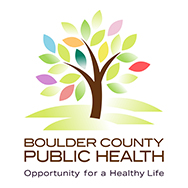Well Water Safety After a Flood
Water wells have been destroyed or compromised due to recent flooding. This may result in a need to:
- Decontaminate the well
- Replace the well’s pump
- Repair the well structure
- Replace the well
- Some combination of these actions
Use of Potentially Contaminated Water
Water from wells that have been flooded should be considered contaminated. Do not use the water from a flooded well for drinking, cooking, washing dishes, making ice, brushing teeth, or even bathing until you have confirmed that the water is safe.
Residents who are concerned about their well water should follow these steps:
- Use boiled or bottled water for drinking, making ice, brushing teeth, washing dishes and preparing food.
- Boil water for three minutes.
- Cool before using.
- Store in sterile covered containers.
Well Water Testing
Boulder County Public Health no longer offers water testing services.
- See a list of local drinking water labs
Decontamination
Bleach Disinfection
Residents can also disinfect water using bleach. Bleach will kill some, but not all, types of disease-causing organisms.
- Add 1/8 teaspoon (or 8 drops) of regular, unscented, liquid household bleach per each gallon of water. Stir well and let it stand for at least 30 minutes before use.
- Store disinfected water in clean covered containers.
Chlorine Disinfection
Using a chlorine rinse after dishwashing can remove any bacterial contamination until the well can be remediated. For dishwashers, set the hot water heater to 160°F. Use a chlorine rinse after washing by hand or using a dishwasher.
- Soak dishes in clean water (bottled or boiled water) mixed with several tablespoons of unscented chlorine bleach.
- After three minutes, remove the dishes and let them air dry without rinsing. Bathing and showering with unsafe well water is not recommended. If doing so, flush out the hot water heater once first; do not get water into your eyes, ears, nose, or mouth, and cover any open wounds.
Fridge filters should also be replaced if well water is contaminated.
Fixing Contaminated Wells
Well Cleanup Safety Precautions
Clean hazards away from wells before cleaning and disinfecting wells and follow these precautions:
- Turn off all electricity to the well before clearing debris. Do not attempt to repair the electrical system unless you are experienced with this type of work. Inspect all electrical connections for breaks in insulation and for moisture. Connections must be dry and unbroken to avoid electric shock.
- Carefully inspect the area around the well for hazards such as:
- Power lines on the ground or in the water
- Sharp metal
- Glass
- Wood debris
- Open holes
- Slippery conditions
- Do not enter the well pit. Gases and vapors can build up in well pits, creating a hazardous environment.
- Before the power is turned back on, a qualified electrician, well contractor, or pump contractor may need to check the equipment wiring system.
- When working with chlorine solutions, wear rubber gloves and protective goggles or a face shield and a protective apron.
- Work in well-ventilated areas and avoid breathing vapors when mixing and handling chlorine solutions.
Disinfection of Wells
- If the well is equipped with an electrical pump, turn off all electricity and clear all debris.
- If needed, repair the electrical system and pump. If you are not experienced with this type of work, contact a qualified electrician, well contractor, or pump contractor.
- Start the pump and run the water until clear. Use the outside faucet nearest the well to drain the potentially contaminated water from the well and keep unsafe water out of the interior household plumbing. If no pump is installed, bail water until clear.
- Close valves to any interior plumbing water.
- Using a 5-gallon bucket, mix the bleach according to the size of the well with 3-5 gallons of water.
- Remove the vent cap.
- Pour the bleach water mixture into the well using a funnel. Avoid all electrical connections. Attach a clean hose to the nearest hose bib and use it to circulate water back into the well for thorough mixing.
- Rinse the inside of the well casing with a garden hose or bucket for 5-10 minutes.
- Open all faucets inside the home and run the water until you notice a strong odor of chlorine (bleach) at each faucet. Turn off all faucets and allow the solution to remain in the well and plumbing for a minimum of 12 hours.
- Attach a hose to an outside faucet and drain the chlorinated water onto a non-vegetated area such as a driveway. Continue draining until the chlorine odor disappears. Avoid draining into open sources of water (streams, ponds, etc.).
- Turn on all indoor faucets and run water until the chlorine odor disappears.
- Repeat testing of water.
Pump Replacement
If a well requires replacing the existing pump, no permitting process is necessary. The Colorado Division of Water Resources recommends that well owners work with a licensed water well contractor to perform the pump replacement.
Well Structure Rehabilitation or Replacement
A well may need additional repair before being operational, in addition to a new pump. If the well can be repaired and put back into use, a well permit is not needed.
If a well must be reconstructed, a permit for a replacement well must be obtained prior to redrilling the well. A licensed water well contractor can help determine if the well can be repaired or if it needs to be replaced.
If a well structure cannot be rehabilitated and a new well is required, the owner must obtain a permit, and the work must be done by a licensed contractor.


